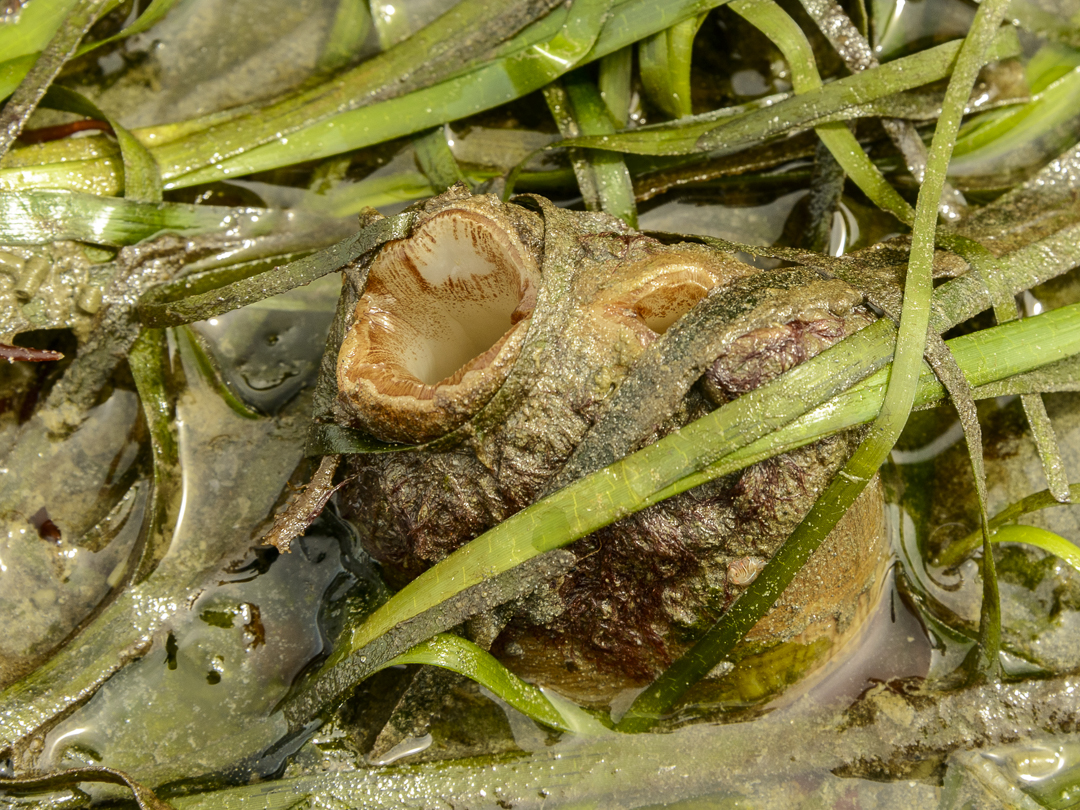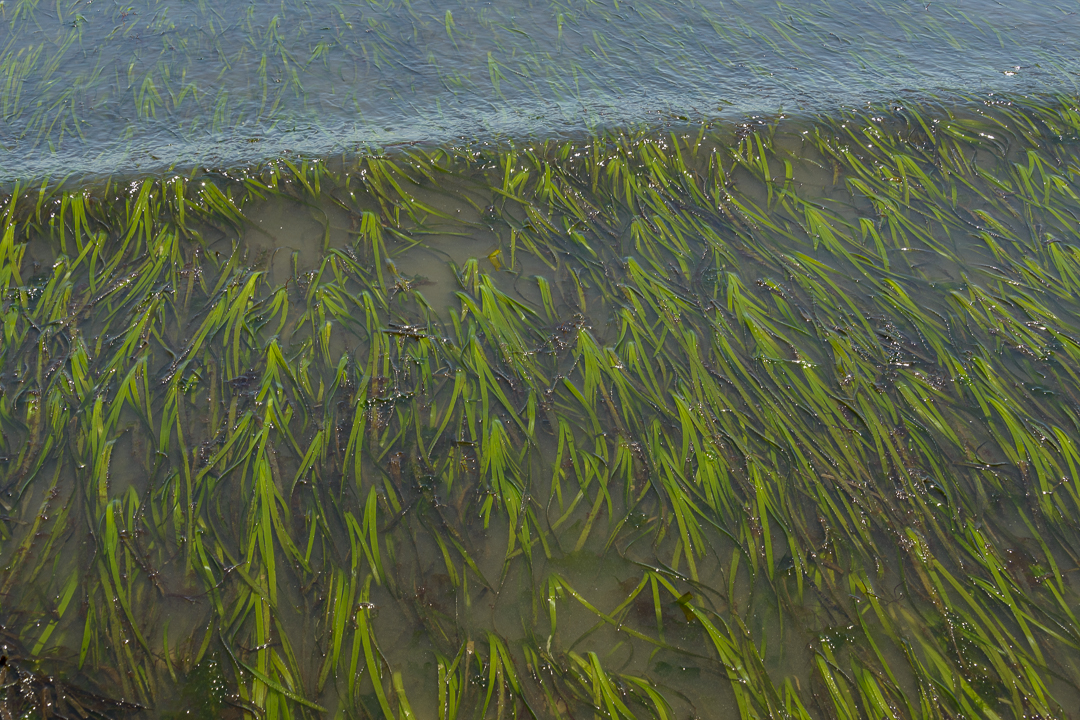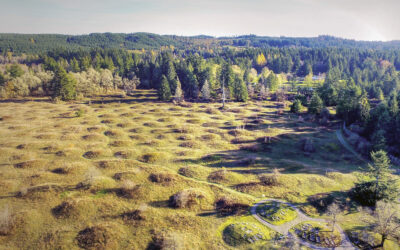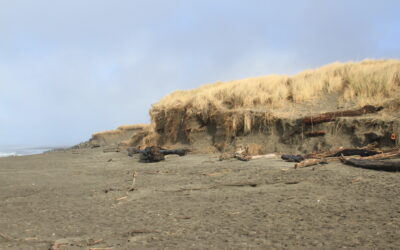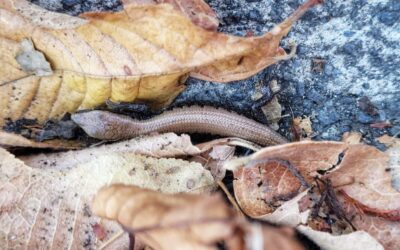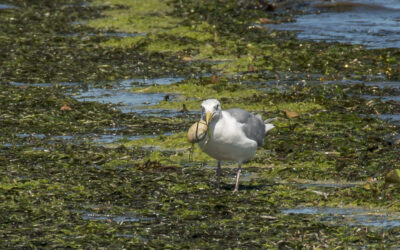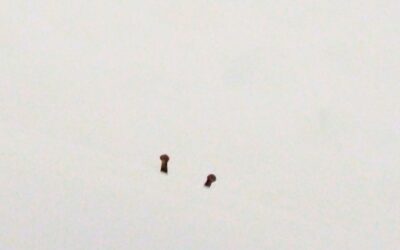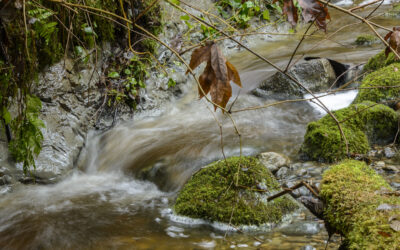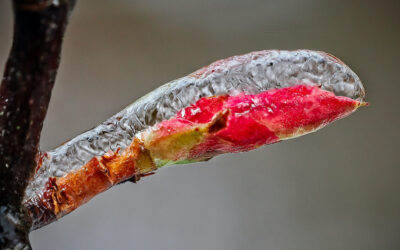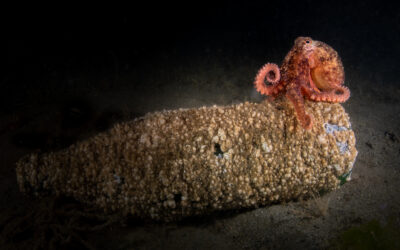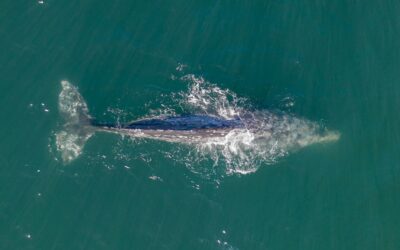A WINDOW ON EELGRASS
by Kylie Rench, Spring 2023
photos by John F. Williams
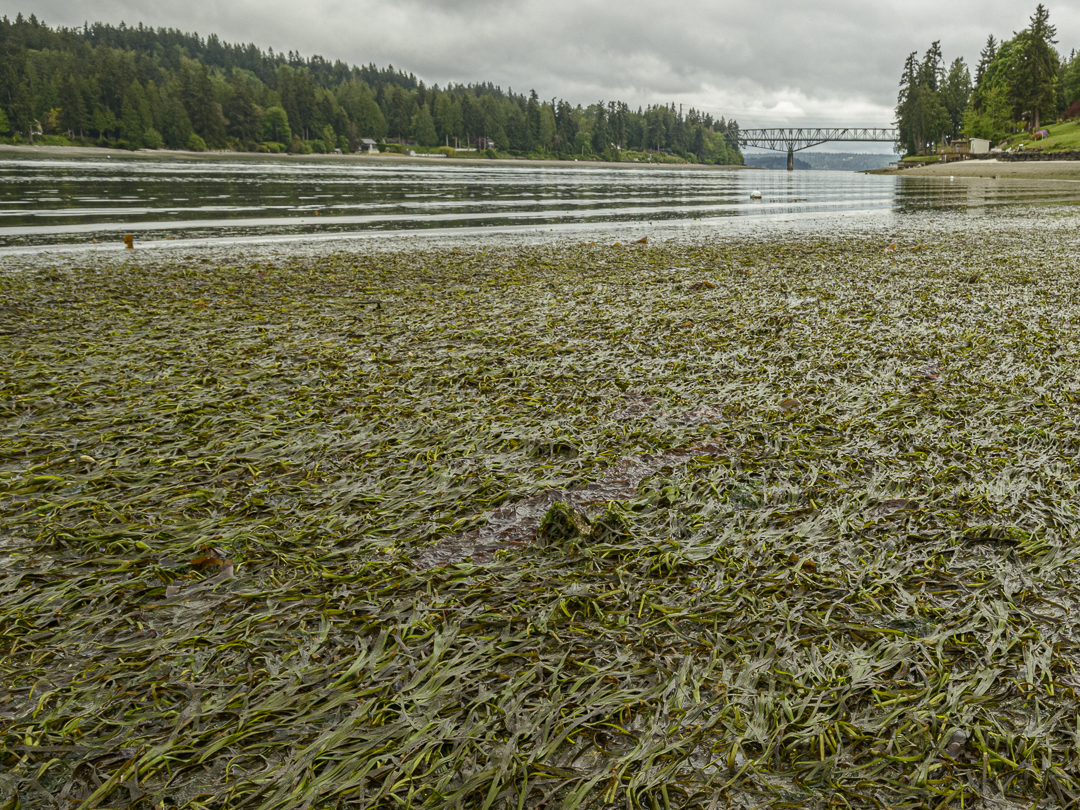
A WINDOW ON EELGRASS
by Kylie Rench, Spring 2023
photos by John F. Williams
Low tide opens a window for the beach walker onto the vibrant world of eelgrass meadows. Submerged by salt water during most tidal cycles, these meadows are places where a complex community of mysterious creatures hide, hunt, graze, migrate, and lay eggs. Look closely among the green fronds exposed at low tide, and you may find crabs, snails, urchins, and nudibranchs. If you’re able to view eelgrass through shallow water, you might see young salmon swimming about, using the meadow as a safe place to rest and move along the shore. In some areas of the Salish Sea, you might see a flock of brant descending to feed on an eelgrass meadow. With so many species at work, and the long blades of eelgrass swaying below the water, these habitats are alive with movement. Some species, such as the bay pipefish, even mimic the look and movement of eelgrass leaves as camouflage in the meadows.
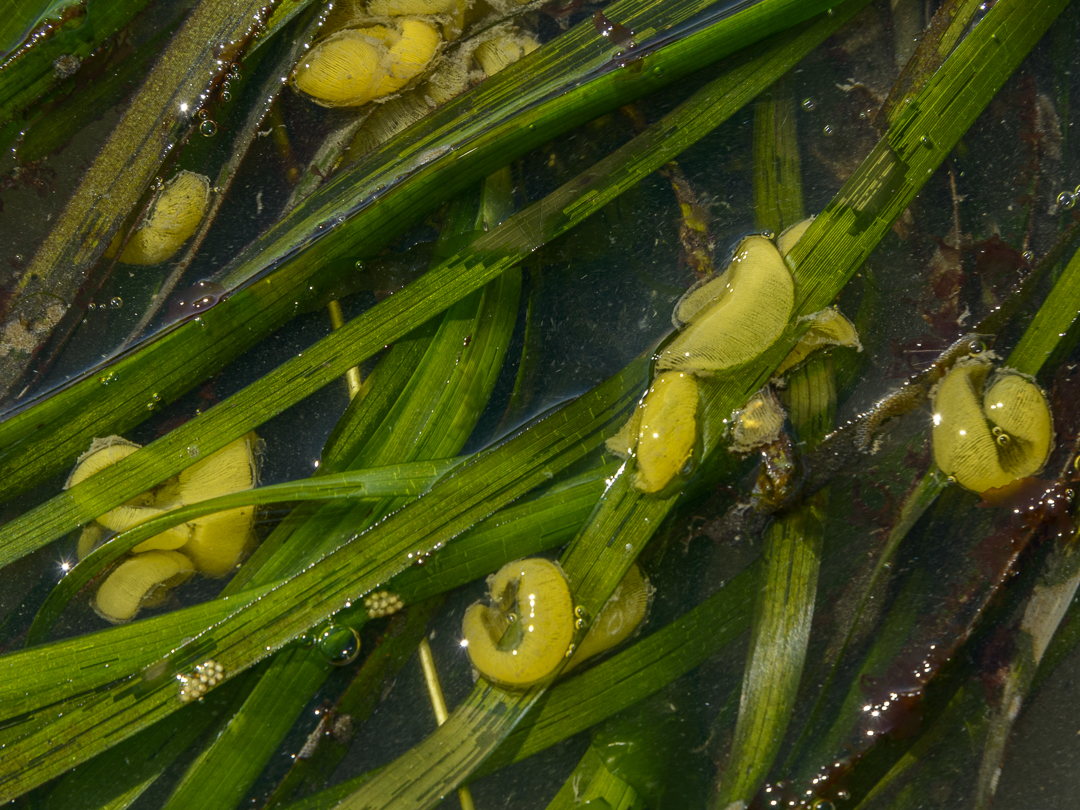
Eggs among the eelgrass: yellow donut-shaped egg ribbons from the white paper bubble shell (Haminoea vesicula) and small clusters of eggs from the carinate dovesnail (Alia carinata).
Living at depths of about three to 30 feet, our native eelgrass (Zostera marina) can usually be visited from land only during lower tides. A non-native species, Z. japonica or dwarf eelgrass, lives slightly higher on the shore. Eelgrass is an angiosperm (flowering plant) unlike algae, seaweed, or kelp. It reproduces via rhizome spreading or pollination of flowers and the production of seeds.
 Learn about eelgrass flowering and how to distinguish between native and non-native eelgrass in another of our articles: https://salishmagazine.org/eelgrass-flowering/
Learn about eelgrass flowering and how to distinguish between native and non-native eelgrass in another of our articles: https://salishmagazine.org/eelgrass-flowering/
Human attitudes and actions toward eelgrass have also been moving over the past few decades. Recognizing both the importance of and threats to native eelgrass has been key. We know that eelgrass meadows provide many functions in addition to wildlife habitat. They are an indicator of estuary health, being sensitive to changes in water quality. Eelgrass roots bind sediment, protecting shorelines from erosion, while the leaves slow currents and protect the inhabitants hiding within. Eelgrass also filters water, traps sediment, and absorbs carbon dioxide. Like other plants, it transforms nutrients into vegetation that can be consumed by other species in the Salish Sea food web.
A video about eelgrass and restoration efforts. video by Bob Turner
We also know that eelgrass beds are damaged by installing bulkheads, dragging anchors and grounding boats in shallow water, installing docks that block sunlight, and releasing excess nutrients and sediments to the water. Recently scientists have recognized an eelgrass wasting disease caused by a marine slime mold, Labyrinthula zosterae, which spreads via leaf to leaf contact. This disease results in damaged leaves, decreased photosynthesis, and eventual death of eelgrass plants.
Agencies and communities in both Washington and British Columbia have undertaken monitoring and mapping of eelgrass beds in the Salish Sea. And in the Salish Sea and elsewhere around the world, there is a push toward eelgrass replanting in an effort to restore habitat and reduce the effects of climate change. Next time you’re on the beach during low tide, keep an eye out for eelgrass and the creatures that live and move through it.
FIND OUT MORE
Resources – eelgrass monitoring and restoration
• Delve into Washington state’s recent eelgrass monitoring work (story map)
• Learn about eelgrass bed mapping in British Columbia
• Learn about seagrass restoration in Puget Sound — why it’s important, what methods have been tried, and how success is monitored (story map)
• Eelgrass restoration efforts are happening in British Columbia as well (narrated video)
• Washington state has a plan to conserve and restore at least 10,000 acres of kelp forest and eelgrass meadow habitat by 2040
Other resources
• Description and natural history of Zostera marina
• Discussion and photos of the “submerged city” of eelgrass from the East Coast
Table of Contents, Issue #19, Spring 2023
Underground Movement
by Amy Porter, Spring 2023 Wolf Haven mounded prairie. photo by Wolf Haven Internationalby Amy Porter, Spring 2023On Wolf Haven’s mounded prairie, there is an underground movement happening that largely goes unnoticed — bioturbation (the movement of soil) by Mazama...
Poetry-19
Spring 2023 photo by Thomas NolandSpring 2023Sand and Water by Jeffrey Hummel Sand infinite amountsappearing all the sameBlowing, shifting, changingAbrasiveA handful you can’t holdSlides through your fingersGets into everythingevery part of youEvery nook, crack...
Lizard’s Locomotion
by Karin Kersteter, Spring 2023 illustrations by Karin Kersteter by Karin Kersteter, Spring 2023illustrations by Karin KersteterThere is an expression “leave the leaves,” which is designed to encourage people to let leaves lie in yards and gardens, rather than rake...
Turbulence
by Rebekah Boettcher, Spring 2023 photos by Rebekah Boettcher except as noted Seagull with clam. photo by John F. Williamsby Rebekah Boettcher, Spring 2023 photos by Rebekah Boettcher except as notedHow did I get here? I ponder, stunned once again as we walk down to...
Learning from a Snail’s Pace
by Michelle Ryder, Spring 2023 Photos by Michelle Ryder except as noted Mapfire peering over the side of the bathtub from inside of it.by Michelle Ryder, Spring 2023 Photos by Michelle Ryder except as notedIn 2022 a snail came into my life. And stayed. Late last...
Movement Imagery
Spring 2023 Cowling Creek, Suquamish. photo by John F. WilliamsSpring 2023Here is a collection of photos and art work depicting various kinds of movement. You may enjoy playing the audio file below as you view the photos. The music evokes the feeling of motion through...
Plant motion
text and photos by John Bolivar, Spring 2023 Ribes sanguineum floral bud encased in ice.text and photos by John Bolivar, Spring 2023At first look it would appear that plants do not have the luxury of movement to help them avoid bad weather — like our recent bout of...
2022 Photo Challenge
by MaST Center Aquarium, Spring 2023 Jurors' Favorite - On the Bottle, Veronika Nagy. Small octopus sitting on a bottle. by MaST Center Aquarium, Spring 2023The Underwater Photography Challenge focuses on bringing divers to Redondo Beach, Washington, to highlight the...
Gray Whales
by Laura Marx, Spring 2023 Gray whale off the Oregon coast. photo by Dan Meyers on Unsplash by Laura Marx, Spring 2023Gray whales and their amazing migrations up and down the west coast of the U.S. have made an impact in my life ever since I was a child. In the 1990’s...
PLEASE HELP SUPPORT
SALISH MAGAZINE
DONATE
Salish Magazine contains no advertising and is free. Your donation is one big way you can help us inspire people with stories about things that they can see outdoors in our Salish Sea region.
We also don't advertise Salish Magazine, so please spread the word of this online resource to your friends and colleagues.
Thanks so much for your interest and your support.
We also don't advertise Salish Magazine, so please spread the word of this online resource to your friends and colleagues.
Thanks so much for your interest and your support.

